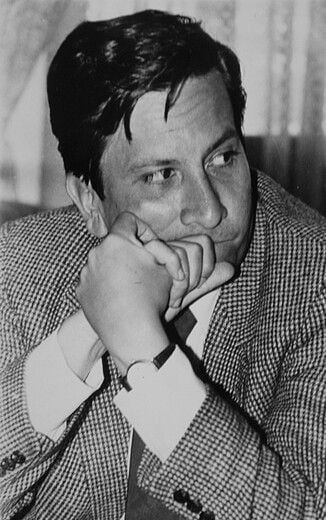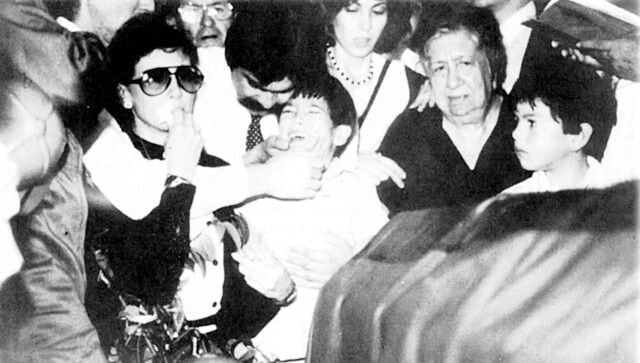:quality(85)/cloudfront-us-east-1.images.arcpublishing.com/infobae/YBXMOOKDPJB3DFOD4O3WNOC3UA.jpg 420w)
Although the escalation of violence in Colombia increased since the middle of the last century, its connotation was another one with the rise of drug trafficking, which had more than one opponent. One of them was Rodrigo Lara Bonilla, who, at the time, was serving as Minister of Justice, which is why he was assassinated under the orders of Pablo Escobar Gaviria.
It is almost 38 years since the assassination that shook the country, it was the first time that a practicing dignitary was murdered in Colombia. A string of calls became a constant for the Lara Restrepo family home, which is why the authorities tried to change telephone lines. The threats ended the peace of mind of the liberal politician and his relatives.

On April 30, 1984, Lara Bonilla received a call early in the morning, from the military leadership they sought to alert him to a possible plan to end his life, his concern was notorious as he listened to the suggestion to change his arteries of mobilization in the streets of Bogotá. During the day he remained worried, walked incessantly and attentive to any alert. He managed to communicate with the lower area of his office and ordered that anyone entering the place be requisitioned, as his unrest persisted.
The night was approaching and the hope of arriving home was latent. However, a black cloud manipulated by criminals sought to obscure Colombia's history on that day: after getting out of her job duties, she managed to cross a few words with then-communications minister Noemi Sanín, who had to get ahead of the road due to other commitments.
Minutes later, Lara boarded the vehicle that was waiting for him, a Mercedes-Benz W123, with white FD 5883 plates, where he was accompanied only by the driver. In addition, two vans guarded the front and rear of the car.
The route changed, but traffic was relentless. Due to the security condition of the politician, the caravan could not stop anywhere. The decision to flow north of the capital was to take a road attached to the eastern hills, which could avoid traffic congestion. On taking 127th Street and approaching the North Highway, one of the vans lost its way due to the interference of other vehicles due to rush hour.
From one moment to another, there was the rumbling of an exhaust coming from a high-cylinder motorcycle, accompanied by this one death was felt, as 25 45 caliber bullets came out of a submachine gun against the Mercedes in which Lara was mobilizing.
Seven bullet wounds were blunt to end the life of this political leader, most of the impacts lodged in the upper part of his body including the head. Later, the motorcycle on which the assassins were transported fell, one of those involved died instantly, while another was captured. Lara was initially driven home, however, her body was already dead. In the midst of the unconsciousness of the moment and with the intention of saving his life, he was transferred to the Shaio Clinic amid the sobs of his family, who confirmed his death minutes later.

Rodrigo Lara Bonilla was characterized as an innate leader from the beginning, as he was only 23 years old he managed to become mayor of his native Neiva. These features led him to enter other diplomatic positions and expand his studies abroad: on his arrival to Colombian territory, he managed to become a senator, however, his differences with the Liberal Party led him to desist from continuing in the community, for this reason he joined Luis Carlos Galán Sarmiento and founded the New Liberalism , with which they participated in the 1982 presidential elections and won the third ballot with almost 800,000 votes. Lara was already beginning to emerge as an important prospect.
His character urged then-President Belisario Betancourt to appoint him as Minister of Justice, a portfolio from which he became the staunch rival of the rise of drug trafficking and the marimbera bonanza: his criticism was strong and he constantly promoted the concept of extradition. When Pablo Escobar came to the Senate, Lara's annoyance was evident, as he questioned the economic development of the Antioquian narco, who defended himself and demanded proof from the then minister. One of the best allies of the murdered political leader was the also murdered editor of the newspaper El Espectador, Guillermo Cano, who, following Lara's allegations, resurrected a news story several years ago, in which Escobar was pointed out that he had been captured for drug possession.
Later, this type of remarks led Pablo Escobar to disappear from the congress, since the loss of his investiture was demanded at the minister's insistence. The narco's response was that Lara had been financed with illicit money from the Amazon, however, this was never confirmed and it seemed to be a trap against the dignitary.
Today, there is still a lack of clarity about his death. Doubts arise about the origin of some shells that were lodged in the chest of the former minister and, in addition, the State is pointed out that it had not granted a vehicle with optimal safety conditions, considering that Lara was offered support from the United States, but he refused it because he did not come from the National Government. Meanwhile, some of his relations with the New Liberalism did not end in the best way, as many at the time turned their backs on the leader who took as his own a struggle of all Colombians.
KEEP READING:
